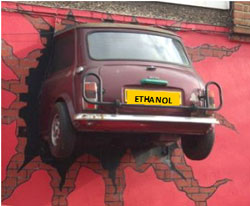The ethanol blend wall is still a reality for the industry, according to the chief economist with the U.S. Department of Agriculture.
“For the time being, I think we are at a blend wall and it’s a pretty hard wall,” said USDA’s Joe Glauber during a recent gathering of farm broadcasters in Washington DC. Glauber says the general feeling now is that the blend wall is about 13.5 billion gallons. “What gets produced in excess of that has to go out through the export market,” he said. “Last year we had a spectacular year, exporting more than a billion gallons, but most people think that won’t happen this year.” He expects Brazil in particular will not import as much ethanol this year.
 While the industry is moving steadily toward the 15 billion gallon corn ethanol cap under the Renewable Fuel Standard (RFS2), Glauber says right now the market is steady at about 10 percent of ethanol blended fuel and getting E15 in the marketplace is moving slowly toward reality. “But you still have the underlying economics of whether or not a gas station is going to change over equipment to be able to sell E15,” he said. “The likely thing would be so-called blender pumps, which are expensive propositions.”
While the industry is moving steadily toward the 15 billion gallon corn ethanol cap under the Renewable Fuel Standard (RFS2), Glauber says right now the market is steady at about 10 percent of ethanol blended fuel and getting E15 in the marketplace is moving slowly toward reality. “But you still have the underlying economics of whether or not a gas station is going to change over equipment to be able to sell E15,” he said. “The likely thing would be so-called blender pumps, which are expensive propositions.”
The expense of putting in blender pumps for stations can be offset by numerous federal, state and industry programs that offer grants and incentives to stations, but the oil companies are still putting up walls to discourage station owners from doing so. Last week, the American Petroleum Institute (API) proclaimed that EPA approval of E15 poses “serious safety and environmental concerns for consumers” because “an estimated half of all gasoline station equipment is not compatible with E15.”
Listen to Glauber’s comments here: USDA Chief Economist Joe Glauber
While there are some legitimate concerns with infrastructure, the industry is actively working with all stakeholders to address any safety issues regarding E15. “The nation didn’t have the infrastructure in place for a transcontinental railroad, but that didn’t stop us from moving forward because it was in the best interest of the nation. The same is true with America’s fueling infrastructure,” said Matt Hartwig with the Renewable Fuels Association (RFA). “Because some upgrades may be needed is no reason to accept the status quo as the best we can do.”
RFA has a website dedicated to E15 information (www.E15fuel.org), a misfueling mitigation plan to help retailers avoid confusion, and an E15 Retailer Handbook for gas station owners seeking to offer E15.

